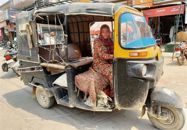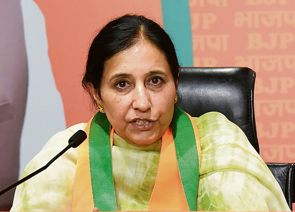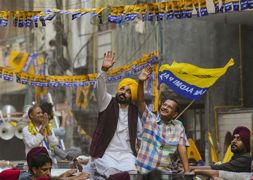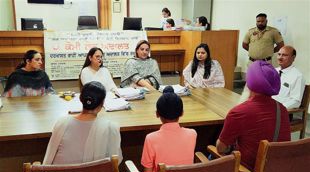
revolutionaries: Busts of Naxalite leader Charu Majumdar (centre) and other ideologues at Naxalbari in West Bengal. twitter
ABHIJIT BHATTACHARYYA
Author and Columnist
MUCH-FEARED Bengali Naxalite leader Charu Majumdar, prior to his death in Calcutta Police custody in July 1972, confessed: “Discussed the growing struggle in Punjab and opined that the struggle in Punjab would develop more and more following the line of Charu Majumdar.” The world knows that Majumdar believed in the use of guns during the class struggle. Yet, the question remains: How did the ‘struggle in Punjab’ crop up for Majumdar? At that time, Punjab wasn’t under the influence of Communists, Naxalites or Maoists. However, did the CIA-ISI-sponsored/guided Khalistan movement of later years have links with the Chinese, sowing the seeds of a movement which almost led to a devastating polity change in India?
Another dying statement of Majumdar clarified: “Why we selected Naxalbari as the site of launching the struggle… because the area had advantages of geographical location.” Both ultra-Left, foreign supported and masterminded Naxalite destruction of Bengal in the 1960s-1970s and ultra-Right, foreign-assisted Khalistani devastation of Punjab in the 1980s-1990s were a heady mixture of extreme ideology with ‘advantages of geography’.
Finally, Majumdar admitted: “We were also getting money from Canada. On one occasion, Hardayal Singh brought Rs 10,000 from Canada to hand over to us.” One can legitimately fill in the blanks of the pockets of unrest in independent India. Were Hindu-Bengali Naxalites and future Sikh Khalistanis two sides of the same coin? Was the Pakistan army-ISI duo the midwife for Nixon-Kissinger-Mao in 1971-72? Violence involving Hindu Bengalis in the 1960s-1970s was followed by violence involving Sikhs in Punjab in the 1980s-1990s. Strange similarity!
Punjab undoubtedly represented the climax of the drama. But how and where did it all start? Obviously, it started with 1947 — the targeted breakup of two largest provinces of British India — Bengal and Punjab. It mauled the Bengalis and the Punjabis, leaving millions scarred on both sides of the fence, resulting in the simultaneous creation of a band of windfall beneficiaries of blood-soaked spoils.
Obviously, it’s easy for scheming elements to foment trouble when the demography is shattered and the geography is fractured. Both Bengal and Punjab not only faced congenital hostility of the two-winged Pakistan, adding to India’s woes, but also gave diabolical Communist Party of China (CPC) dictator Mao Zedong a chance to target the east. Bengal was set on fire as the new rulers of Delhi brazenly ignored and miserably failed to address the plight of genuine Bengali-speaking refugees from the east from the beginning of the Indian state’s journey.
Bengali refugees became either pariah or pawns in Delhi’s political laboratory. They were thrown out of their homes by East Pakistan and chronically insulted by ‘Hindu-brethren’ rulers of the new Indian state; the sane, tall leader Dr BC Roy stood out, trying to ameliorate the plight of millions in distress. The danger to Delhi was written on the wall.
Mao himself had signalled long ago while fighting the civil war in the 1940s: “China’s war of resistance is an extraordinary spectacle in the history of warfare. It would in future influence not only the fate of China, but also surge forward progress of all countries, in particular of oppressed peoples such as India to march forward.”
Strangely, Bengal and Punjab were again the only two regions of independent India to be gripped by mindless violence. The first salvo was fired on May 24, 1967, at Naxalbari, a north Bengal hamlet. The fire spread wild and wide, engulfing the eastern border state for a decade and a half, thereby inflicting colossal loss of men, money, material and industrial manufacturing. For the first time, the Centre faced the threat a wounded/fractured border state could pose to its sovereignty if problems remained unaddressed or unresolved without care and sensitivity.
Once the Bengal fire was doused with an iron hand by the then Prime Minister, Indira Gandhi, with an estimated 50,000 lives lost and monumental hidden cost, unrest started in Punjab in the 1970s. What China did directly to Bengal (along with indirect western connivance), taking on board a few thousand Communist Hindu Bengalis as proxy foot soldiers, Pakistan did the same to Punjab with the assistance of the US, the UK and Canada, manipulating a section of the Sikh peasantry which gave a torrid time to the Indian state for more than a decade for its failure to address the perceived grievances of Punjab.
In retrospect, the most striking common feature of the Bengal-Punjab imbroglio, however, was the repulsive tendency to stigmatise the entire community by a section of ostentatiously educated elite. It started with branding of linguistic Bengali as ‘Communist, Naxalite, treacherous’ in the 1960s; the Sikhs faced an identical, humiliating racial profiling in the 1980s — ‘ungrateful, unreliable, untrustworthy’. It’s pathetic to see the humiliation of people of two proud, but partitioned regions, whose indisputable leading role in the Indian freedom movement stands permanently inscribed on the walls of Cellular Jail of the Andaman and Nicobar Islands.
Coming back to Majumdar’s dying statement, doesn’t a new vista seem more than plausible? Can there be any doubt pertaining to the role that Communist China and the capitalist West played along with Pakistan to harm India from the 1960s to the 1990s? Hope India has learnt a lesson to forestall future uncertainties or eventualities triggered by Communist China, Pakistan Army-ISI and the West. And, let the British-era tradition of racial profiling of versatile but potentially volatile Bengalis and Punjabis be eschewed.
Join Whatsapp Channel of The Tribune for latest updates.




























